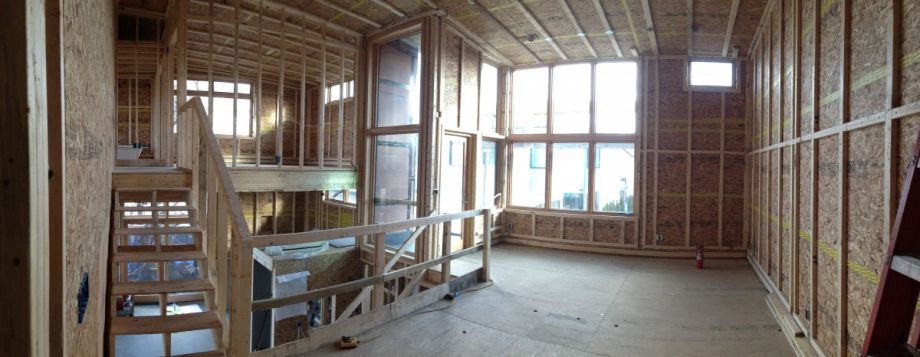On a Tuesday morning not long ago, I entered a half-assembled house tucked into a quiet corner of Somerville, Mass. In much of this small city, adjacent to Cambridge, you can no longer walk down the block without passing a yoga studio or an artisanal butcher. But this residential street still felt more like the blue-collar town of a previous generation. Outside, a yellow crane lifted a floor deck high overhead. A few men wearing hard hats and tool belts busied themselves inserting screws and climbing ladders.
I stood with Ethan Lacy, one of the architects who designed the house, in the middle of a space that would become an airy living/dining room. All but one of the walls were made of pressed wood chips, later to be covered with sheet rock. A single glass wall — picture eight-foot transparent doors surrounded by windows — looked out onto railroad tracks and a graffiti-covered industrial building.
“Yesterday morning there was nothing here,” said Lacy. “The shell will be finished tomorrow.”
The house is the brainchild of Adele Naude Santos, dean of MIT’s School of Architecture and Planning, and is squeezed between Santos’s home — a converted bronze foundry — and a six-unit condo building. With a split-level second floor, high ceilings and generous windows, the house is a photogenic ambassador for the movement to bring prefab housing into urban settings.
Prefab offers a number of advantages, most obviously the speed of on-site assembly, which minimizes neighborhood disruption. The approach also lends itself to resourceful use of materials, as well as greater precision of construction, which fosters energy efficiency.
The prefab movement is not new. For decades, architecture critics have been proclaiming the arrival of its heyday, only to be disappointed when it failed to catch on. Some, such as Allison Arieff and Christopher Hawthorne, now believe that prefab’s greatest promise lies in larger, multifamily residential buildings. Developers have begun to think about how the method could transform costly and time-consuming construction of high-rises.
Though the single-family home in Somerville is more of a niche project — Lacy expects it to sell for more than $1 million — it offers compelling evidence of prefab’s benefits. Unlike on-site construction, the vast majority of the work occurred at a 50,000-square-foot studio in New Hampshire. Bensonwood, a 40-year-old firm with 80 employees, took Lacy’s architectural drawings and translated them into 3D models. The models were connected to a “computer numerical control” system that cut all of the panels and parts.
Though each of Bensonwood’s buildings is unique, the firm uses a limited “library” of interchangeable panels, which contributes to the efficiency. Tedd Benson, the founder, compares them to Legos. (The term “prefab” is actually somewhat contentious. For the record, Benson does not identify with it, for reasons he explains here.) The house’s shell was assembled in three days; see this time-lapse video for an accelerated version of the process.
Once completed, the house is expected to be significantly more energy-efficient than the state’s strict energy code requires. Of course, many factors influence this characteristic. In fact, the house is “not a superinsulated house by any means,” according to Chris Carbone, a Bensonwood engineer. But the precision of the construction gives prefab houses an intrinsic edge. “One of the biggest ways buildings lose energy is through air leaks,” Lacy said. A house constructed with less human error, and without the time pressure of building on site, is less prone to gaps that lead to such leaks. Bensonwood panels are cut to within a 32nd of an inch.
“That would be hard to do for a guy with a measuring tape and a saw,” Benson said.
Sheri Koones, author of the forthcoming book Prefabulous World: Energy-Efficient and Sustainable Homes around the Globe, agrees. Prefab houses, she said, are “just built more carefully. I think the energy efficiency is definitely related to the quality of the labor.” She added that it also reduces construction waste. “When somebody’s building a house, you see a big dumpster in front of the house that fills up with materials. In a factory a lot gets recycled.”
The home-building industry on the whole is surprisingly out of step with technological advances that have revolutionized so many other sectors of the economy. Though some builders have begun to incorporate computers into parts of their processes, Bensonwood is unusual in its use of 3D modeling in conjunction with the computer-directed saws and other tools.
The prefab movement has stalled for various reasons. “The real estate market is super conservative,” said Arieff, editorial director for the San Francisco urbanist group SPUR. There’s resistance from unions who fear losing work, and lenders are disinclined to take risks on an unfamiliar approach.
In the past couple of years, several high-profile high-rise projects have attracted renewed media attention to the concept. The Broad Group, a Chinese construction company specializing in prefab, built a 30-story hotel in 15 days, and is planning to build a 202-story skyscraper, which would be the world’s tallest. In 2012, Forest City Ratner announced with great fanfare its plans to build a 32-story prefab residential tower at Atlantic Yards in Brooklyn. But almost two years later, the Times recently reported, only five of the floors have been erected.
Given the mixed results so far, it’s too soon to say whether high-rise prefabs will turn into the wave of the future or another disappointment. Bensonwood works on a smaller scale, and doesn’t claim to be starting any trends. But elements of its building method and technology may be worth emulating.
“The American consumer is being pretty underserved,” Benson said, adding that housing construction offers “less efficiency, less precision, less assuredness of quality consistency.” He hopes more companies will begin to employ the “manufacturing technology, computer technology, 2014 technology that we see in everything else.”
The week after my initial visit, I returned to the house, which was now a completed shell. It already felt home-like; its inviting simplicity did not evoke sophisticated technology. Outsourcing the “dumb work,” Benson said, means builders can focus on the “smart work.” Of the machine, he said, “She is tireless, and she is accurate.”
The Science of Cities column is made possible with the support of the John D. and Catherine T. MacArthur Foundation.
Rebecca Tuhus-Dubrow was Next City’s Science of Cities columnist in 2014. She has also written for the New York Times, Slate and Dissent, among other publications.

















